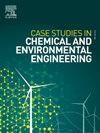Fuel potential of bio-oil from co-pyrolysis of fresh palm fruit bunches and waste cooking oil sludge: composition, fuel properties, and carbon distribution analysis
Q1 Environmental Science
Case Studies in Chemical and Environmental Engineering
Pub Date : 2025-07-19
DOI:10.1016/j.cscee.2025.101265
引用次数: 0
Abstract
This study investigates the co-pyrolysis of fresh palm fruit bunches (FFB) and waste cooking oil sludge (WCOS) in a batch pyrolyzer at various ratios (FFB:WCOS, 100:0 to 25:75). Increasing the WCOS ratio reduced the bio-oil yield (from 36.8 % to 25.8 %) but improved the quality. GC–MS revealed more long-chain alkanes, alkenes, and nitriles (e.g., hexadecanenitrile). The lower heating value rose to 42.2 MJ/kg, and the viscosity (2.7 cSt) was comparable to diesel fuel standards. These results indicate that co-processing FFB and WCOS produces bio-oils with favorable fuel properties, offering a sustainable route for the utilization of agricultural biomass and industrial waste.

新鲜棕榈果束和废烹饪油泥共热解生物油的燃料潜力:组成、燃料特性和碳分布分析
本文研究了新鲜棕榈果束(FFB)和废食用油污泥(WCOS)在不同比例(FFB:WCOS, 100:0 ~ 25:75)的间歇热解装置中的共热解。提高WCOS比可降低生物油收率(由36.8%降至25.8%),但提高生物油品质。GC-MS显示更多的长链烷烃、烯烃和腈(如十六烯腈)。较低的热值上升到42.2 MJ/kg,粘度(2.7 cSt)与柴油燃料标准相当。这些结果表明,将FFB和WCOS协同处理可以生产出具有良好燃料性能的生物油,为农业生物质和工业废弃物的可持续利用提供了一条途径。
本文章由计算机程序翻译,如有差异,请以英文原文为准。
求助全文
约1分钟内获得全文
求助全文
来源期刊

Case Studies in Chemical and Environmental Engineering
Engineering-Engineering (miscellaneous)
CiteScore
9.20
自引率
0.00%
发文量
103
审稿时长
40 days
 求助内容:
求助内容: 应助结果提醒方式:
应助结果提醒方式:


